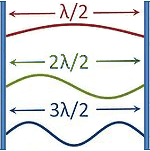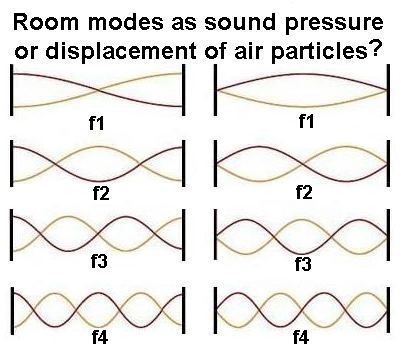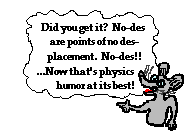

| Deutsche Version |
| The table below summarizes the features of the standing wave of
sound in air as sound pressure p for the first harmonics between
two hard reflecting walls. Sound technicians should know this. The 1st harmonic is the fundamental frequency of the standing wave. |
of Nodes |
of Antinodes |
Patterns Room walls |
Relationship |
|
| The table below summarizes the features of the standing wave as particle displacement ξ for the first several harmonics of a clamped string, which must be fixed at the two end points. |
of Nodes |
of Antinodes |
Patterns String |
Relationship |
|
| In the figure on top the sound pressure of a sine wave with harmonics is
presented between two totally reflecting walls which in reality is a
longitudinal wave. It is important that in the case of resonance there is always a maximum sound pressure on the walls. In many figures this is wrongly shown as a vibration of a string, which has always a fixed node (knot) at each end, as in the following example: |
| This is not the representation of sound pressure vibrations between walls in a small room. These are vibrations of a string (displacement amplitudes). |
 |
A typical wrong figure with nodes at the wall. Showing the air displace- ment is not wanted. |
| A string is clamped between two "fixed ends". At the ends will be a wave node. A wave between two hard walls is considered as a sound pressure with "loose ends". Therefore on the sides of the wall there appears as sound pressure a wave maximum or an antinode. Sound technicians are looking at room modes only for the amplitude of the sound pressure p (sound pressure amplitude), because this quantity moves our eardrums and let us hear the disturbing low-frequency room modes. Not interesting is the amplitude of sound displacement ξ (amplitude of the air particle deflection), the amplitude of the particle velocity v, and the amplitude of the pressure gradient Δ p; see: "What is an amplitude?" and "Soundfield Quantities of a Plane Wave − The Amplitudes". |
| Note, because there is often confusion: An antinode in sound pressure (pressure antinode) is at the same time a node in the displacement of the air particles (particle displacement node). The problem is that it is mostly forgotten to tell the viewer of the figures what they see: sound pressure variations or motion of particle displacement. |
 |
| The formation of standing sound waves in air at sound hard walls (room
modes) has to be distinguished from the vibrations of a string between two
clamped points. Conclusion: The requirement for a room mode is a standing wave, but standing waves must be no room modes. For an oscillatory system it is generally applicable that the amplitude, or more precisely, the sound pressure amplitude is much more pronounced when the excitation is performed with an eigenfrequency of the system. This special case is generally referred to in physics as a resonance, see: "Standing waves (acoustic resonance) on ideal strings": http://www.sengpielaudio.com/StandingWaves.htm "Calculation of the three room modes of rectangular rooms": http://www.sengpielaudio.com/calculator-roommodes.htm A sound wave is reflected back and forth between two parallel walls. At a given wavelength λ = 2 × L (L = room length, width or height) both waves fit exactly superimposed und deliver a full standing wave. If the distance of the parallel walls is just a multiple of the half wavelength, there are 'standing' waves, which is a sound pressure increase.The frequency at which this happens, is called resonant frequency or room mode. At frequencies that are not a multiple of this frequency, the sound pressure maxima are located at different locations, whereby the effects partly cancel and standing waves are small or even extinguish. In practice, only low frequencies below 300 Hz are heard as room modes. Higher modal frequencies become less important because their interference effect is masked by other room acoustic effects. Close to reflective walls modes always show up that are sound pressure maxima - which are antinodes when you think of the important sound pressure deviations. |
 |
| Courtesy: www.classroom.com |
| back |
Search Engine |
home |